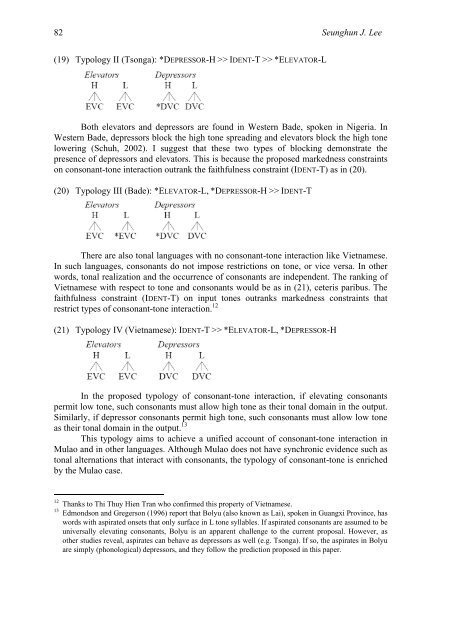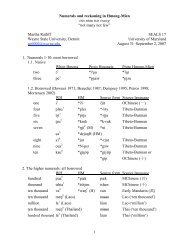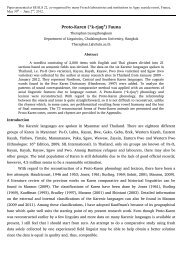proto-southwestern-tai revised: a new reconstruction - seals 22
proto-southwestern-tai revised: a new reconstruction - seals 22
proto-southwestern-tai revised: a new reconstruction - seals 22
You also want an ePaper? Increase the reach of your titles
YUMPU automatically turns print PDFs into web optimized ePapers that Google loves.
82 Seunghun J. Lee<br />
(19) Typology II (Tsonga): *DEPRESSOR-H >> IDENT-T >> *ELEVATOR-L<br />
Both elevators and depressors are found in Western Bade, spoken in Nigeria. In<br />
Western Bade, depressors block the high tone spreading and elevators block the high tone<br />
lowering (Schuh, 2002). I suggest that these two types of blocking demonstrate the<br />
presence of depressors and elevators. This is because the proposed markedness constraints<br />
on consonant-tone interaction outrank the faithfulness constraint (IDENT-T) as in (20).<br />
(20) Typology III (Bade): *ELEVATOR-L, *DEPRESSOR-H >> IDENT-T<br />
There are also tonal languages with no consonant-tone interaction like Vietnamese.<br />
In such languages, consonants do not impose restrictions on tone, or vice versa. In other<br />
words, tonal realization and the occurrence of consonants are independent. The ranking of<br />
Vietnamese with respect to tone and consonants would be as in (21), ceteris paribus. The<br />
faithfulness constraint (IDENT-T) on input tones outranks markedness constraints that<br />
restrict types of consonant-tone interaction. 12<br />
(21) Typology IV (Vietnamese): IDENT-T >> *ELEVATOR-L, *DEPRESSOR-H<br />
In the proposed typology of consonant-tone interaction, if elevating consonants<br />
permit low tone, such consonants must allow high tone as their tonal domain in the output.<br />
Similarly, if depressor consonants permit high tone, such consonants must allow low tone<br />
as their tonal domain in the output. 13<br />
This typology aims to achieve a unified account of consonant-tone interaction in<br />
Mulao and in other languages. Although Mulao does not have synchronic evidence such as<br />
tonal alternations that interact with consonants, the typology of consonant-tone is enriched<br />
by the Mulao case.<br />
12 Thanks to Thi Thuy Hien Tran who confirmed this property of Vietnamese.<br />
13 Edmondson and Gregerson (1996) report that Bolyu (also known as Lai), spoken in Guangxi Province, has<br />
words with aspirated onsets that only surface in L tone syllables. If aspirated consonants are assumed to be<br />
universally elevating consonants, Bolyu is an apparent challenge to the current proposal. However, as<br />
other studies reveal, aspirates can behave as depressors as well (e.g. Tsonga). If so, the aspirates in Bolyu<br />
are simply (phonological) depressors, and they follow the prediction proposed in this paper.





